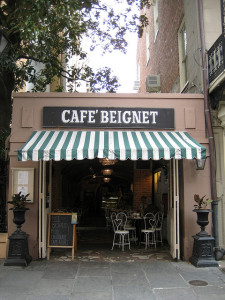Last week I got back from that special time of year for all prospect researchers…APRA International’s Annual Prospect Development Meeting! For the non-prospect researchers out there, APRA International is the primary professional organization for prospect researchers, managers, and affiliates. The once a year international conference is 4+ days of workshops, seminars, vendor demos, and networking. And of course, conference swag.

This year’s APRA International was full of firsts for me. First time presenting, first time meeting several researchers I’ve only interacted with through Twitter, first time time going to New Orleans, first time eating shrimp everyday for four days straight. It was all beautiful.
My colleague Catherine Cefalu does a daily recap of the conference, available on her YouTube channel here. For my part, here were questions and challenges from my colleagues that I

left APRA Prospect Development 2015 pondering:
- How Does Prospects’ Gender Affect My Research? : Preeti Gill and Jennifer Filla’s presentation on researching wealthy women made me reconsider how I was researching couples and how prospects’ gender affects their cultivation, solicitation, and stewardship. My biggest takeaway from the talk was to be more creative in how I looked for information on female prospects–since women are not in executive or board positions as often as men, and their wealth is often inherited (though not always), they may not appear on the “rich lists” and other traditional sources for prospecting.
- How Do Societal Views of Non-Profits Affect Our Impact?: The keynote speaker, TED talk alum Dan Pallotta, argued that non-profits are held back from achieving their goals by a series of unspoken rules, such as “overhead deducts from the mission,” and “non-profit employees should not earn as much money as their for profit counterparts.” I didn’t agree off the bat with some of his arguments, but he certainly made me think, which I appreciate. I’m planning on reading his book about non-profits in the U.S.A.
- Communicate: Every single session I attended and every single researcher I spoke to talked about the importance of communication in their work and the challenge of communicating effectively. Didn’t matter how large or small their shop was, or how many years they had been in the field, or what their expertise was, they all talked about communication. This was a good reminder that “good communication skills” however cliche, are always in demand and that effective communication is a moving target.
- Be Fearless with Tech!: My co-presenter, John Connelly of Northwestern, gave a practical breakdown on how and why he learned Python to help him complete research-related tasks. Now I’m inspired to reconsider how I can use technology, even forms with which I’m not familiar (yet) to make my work easier. Learning new skills is always a little scary, but his presentation certainly demonstrated how being fearless and willing to try new things can really pay off.
- Be Willing to do Some Old-Fashioned Fieldwork!: My colleagues Lindsey Royer, Namrata Padhi, and Melissa Carpenter did a very informative session on industry outlook, compensation, and philanthropy in law, private equity, and pharmaceuticals. One of the reasons their session was so informative was that they interviewed people in the industry. As a former anthropology student, I heartily approve–talking to someone actually working in the field gives a fresh perspective and up to date info that can be hard to access as an outsider. As prospect researchers, we tend to rely on sources we can read–but there’s no reason we can’t do some field research too. Not to mention it can be a good way to engage prospects who aren’t ready to give yet, but are interested in volunteering their time…
And now, for some interesting philanthropic history…
In preparation for visiting New Orleans, I read Black Life in Old New Orleans by Keith Medley. The book was a very good introduction to New Orleans history, especially for someone like me, who has never visited NOLA and doesn’t know much about the city’s past. One chapter of the book was about Madame Marie Couvent, an 19th century philanthropist in NOLA. She was kidnapped from West Africa (specific place unknown) when she was about seven years old, and sold in Saint Dominique. After the Haitian Revolution, she emigrated to New Orleans as a free woman, married Bernard Couvent, another free black man, and proceeded to build a new life for herself and her family. When she died in 1837, her will stipulated that her property in the Faubourg-Marigny neighborhood be used for a school for orphans of color and that “…I declare that said lands and buildings shall never be sold under any pretext whatsoever.”
The land in question has been used as a school ever since. The faculty included poets,

journalists and prominent civil rights advocates. In 1890, Board of Directors president Arthur Esteves and several other directors waged a legal fight against segregated railroad cars that led to the famous United States Supreme Court case of Plessy v. Ferguson. Despite administration changes, two hurricanes, and all of the social and political changes of the last one hundred and seventy-eight years, a school continues to operate on Madame Couvent’s land. Today, the school is St. Gerard Majella Alternative School.
As I wandered through the Faubourg-Marigny and French Quarter neighborhoods, and listened to discussions on the role of philanthropy in the world, I kept thinking about Madame Couvent. On one hand, her gift was so very simple–a school. On the other hand, it was so very sophisticated–I imagine, given her lifelong fight in New Orleans on behalf of black folks and to achieve social/economic standing herself, she knew the power of education and the need for a stable employer and a community center for organizing. And she knew that anything that empowered black folks would be a threat to the established social order, so she locked the purpose of her donation, as best she could, into perpetuity. And it worked–she created something that managed to outlast and dismantle the system that kidnapped her. Madame Couvent’s story is complex and like most philanthropists, it is important to acknowledge her whole history*, but one thing I take from the story of Madame Couvent’s life is the power of thoughtful philanthropy that considers both the long-term and short term needs of a community.
* She and her husband’s activities included buying several slaves in order to free them. This was a common practice among black folks in the 19th century who wanted to free relatives and friends, since the process of manumission was convoluted and took a very long time. However, there is also evidence that Madame and Monsieur Couvent may have also engaged purchasing slaves as a financial investment. The participation in the slave economy by free people of color is complicated issue–for more information about this history and how the students of the school have engaged with Madame Couvent’s philanthropic legacy here are two articles. (Article 1) (Article 2)

One thought on “APRA Prospect Development 2015 Recap + Some NOLA History”
Comments are closed.